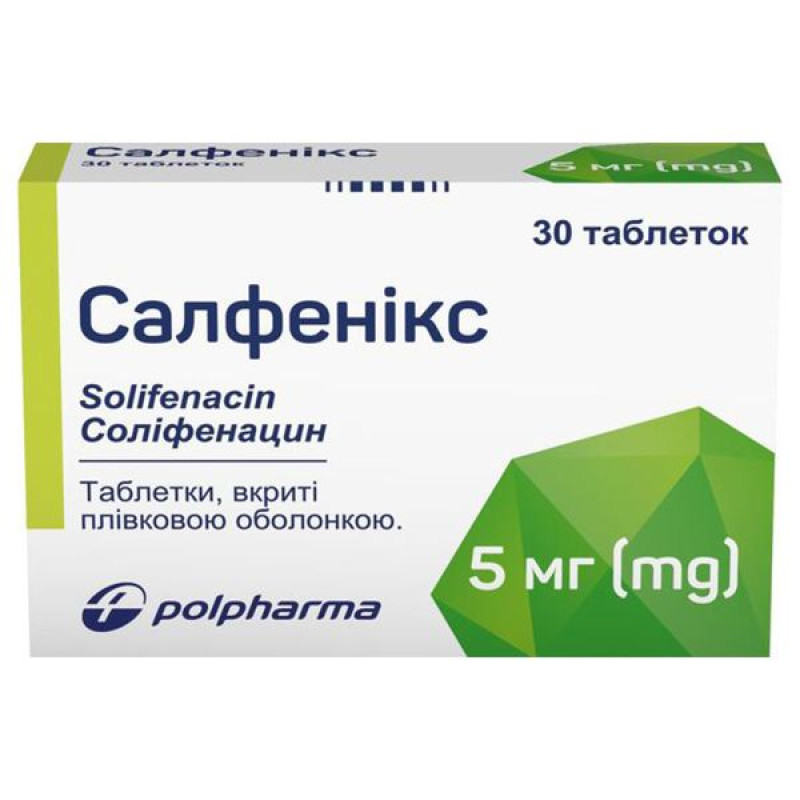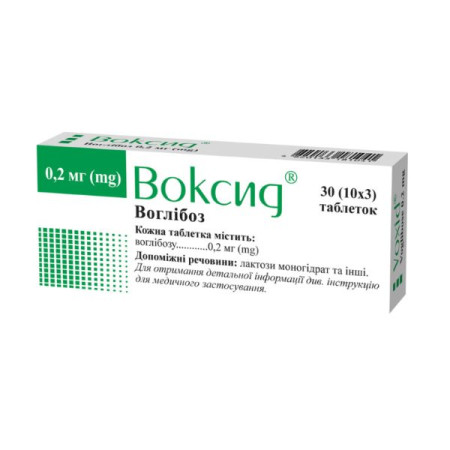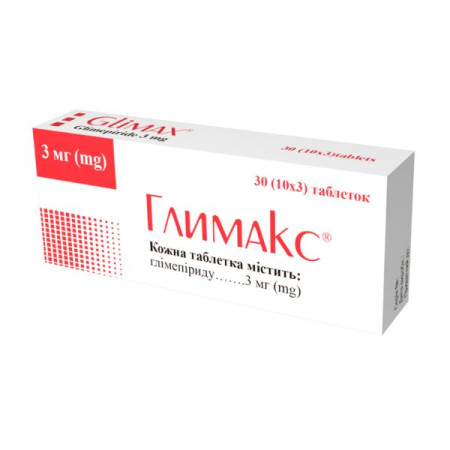Salfenix film-coated tablets 5 mg No. 30

Instructions for Salfenix film-coated tablets 5 mg No. 30
Composition
active ingredient: solifenacin succinate;
1 tablet contains 5 mg or 10 mg of solifenacin succinate, corresponding to 3.77 mg and 7.54 mg of solifenacin, respectively;
excipients: pregelatinized corn starch, lactose monohydrate, sodium stearyl fumarate;
The composition of the coating for 5 mg tablets: hypromellose (6 mPas), titanium dioxide (E 171), lactose monohydrate, macrogol (MW 3350), triacetin, iron oxide yellow (E 172).
for 10 mg tablets: hypromellose (6 mPas), titanium dioxide (E 171), lactose monohydrate, macrogol (MW 3350), triacetin, yellow iron oxide (E 172), red iron oxide (E 172). black iron oxide (E 172).
Dosage form
Film-coated tablets.
Main physicochemical properties: 5 mg tablets – light yellow, round, biconvex tablets, film-coated;
10 mg tablets – pink, round, biconvex, film-coated tablets.
Pharmacotherapeutic group
Drugs used in urology. Drugs for the treatment of frequent urination and urinary incontinence. ATX code G04B D08.
Pharmacological properties
Pharmacodynamics.
Solifenacin is a competitive, specific antagonist of cholinergic receptors. The urinary bladder is innervated by parasympathetic cholinergic nerves. Acetylcholine contracts the detrusor smooth muscle by acting on muscarinic receptors, which are predominantly of the M3 subtype.
In vitro and in vivo studies have shown that solifenacin is a competitive, specific antagonist of cholinergic receptors, predominantly of the M3 subtype. It has also been shown that solifenacin has little or no affinity for other receptors and ion channels tested.
The efficacy of the drug, which was studied in several double-blind, randomized, controlled clinical trials in men and women with overactive bladder syndrome, was observed as early as the 1st week of treatment and stabilized over the next 12 weeks of treatment. In open-label studies with long-term use, efficacy has been shown to be maintained for at least 12 months.
Pharmacokinetics.
Absorption. After taking the tablets, the maximum concentration of solifenacin in the blood plasma (Cmax) is reached after 3-8 hours. The time to reach the maximum concentration (tmax) does not depend on the dose of the drug. The values of Cmax and area under the curve (AUC) increase proportionally to the dose in the range from 5 mg to 40 mg. Absolute bioavailability is approximately 90%. Food intake does not affect the values of Cmax and AUC of solifenacin.
Distribution: Solifenacin is extensively (almost 98%) bound to plasma proteins, primarily α1-acid glycoprotein.
Metabolism: Solifenacin is extensively metabolized in the liver, primarily by cytochrome P450 3A4 (CYP3A4). The systemic clearance of solifenacin is approximately 9.5 l/h and the terminal half-life is 45–68 hours. After oral administration, 1 pharmacologically active (4R-hydroxysolifenacin) and 3 inactive metabolites (N-glucuronide, N-oxide and 4R-hydroxy-N-oxide of solifenacin) have been identified in plasma in addition to solifenacin.
Excretion: After a single dose of 10 mg [14C-labeled]-solifenacin, approximately 70% of the radiolabel is recovered in the urine and 23% in the feces. In the urine, approximately 11% of the radiolabel is excreted as unchanged active substance; approximately 18% as the N-oxide metabolite, 9% as the 4R-hydroxy-N-oxide metabolite and 8% as the 4R-hydroxymetabolite (active metabolite).
Dose dependence. In the therapeutic dose range, the pharmacokinetics of the drug are linear.
Features of pharmacokinetics in certain categories of patients.
Age. No dose adjustment is necessary based on age. Studies have shown that exposure to solifenacin (5 and 10 mg), expressed as AUC, was similar in healthy elderly volunteers (65 to 80 years) and healthy young and middle-aged volunteers (< 55 years). The mean rate of absorption, expressed as tmax, was slightly slower and the terminal half-life was approximately 20% longer in elderly patients. These small differences are not clinically relevant.
The pharmacokinetics of solifenacin have not been studied in children and adolescents.
Gender: The pharmacokinetics of solifenacin are independent of the patient's gender.
Race: Race does not affect the pharmacokinetics of solifenacin.
Renal impairment. AUC and Cmax of solifenacin in patients with mild and moderate renal impairment differ slightly from those in healthy volunteers. In patients with severe renal impairment (creatinine clearance < 30 ml per minute), solifenacin exposure is significantly higher - an increase in Cmax of approximately 30%, AUC of more than 100% and half-life of more than 60%. A statistically significant relationship between creatinine clearance and solifenacin clearance was observed. Pharmacokinetics in patients undergoing hemodialysis have not been studied.
Hepatic impairment. In patients with moderate hepatic impairment (Child-Pugh score 7 to 9), Cmax is unchanged, AUC is increased by 60%, and half-life is doubled. Pharmacokinetics in patients with severe renal impairment have not been studied.
Indication
Symptomatic treatment of urge incontinence and/or frequent urination, as well as the urge to urinate, typical of patients with overactive bladder syndrome.
Contraindication
- Patients with hypersensitivity to the active substance or to any of the excipients;
- Patients with urinary retention, severe gastrointestinal diseases (including toxic megacolon), myasthenia gravis or angle-closure glaucoma and patients at risk of developing these conditions;
- During hemodialysis (see section "Pharmacokinetics");
- Patients with severe hepatic impairment (see section "Pharmacokinetics");
- Patients with severe renal impairment or moderate hepatic impairment who are being treated with strong inhibitors of cytochrome CYP3A4, such as ketoconazole (see section “Interaction with other medicinal products and other types of interactions”).
Interaction with other medicinal products and other types of interactions
Pharmacological interactions.
Concomitant administration of other drugs with anticholinergic properties may result in more pronounced therapeutic and undesirable effects. After discontinuation of Salfenix, an interval of approximately one week should be observed before administration of subsequent anticholinergic drugs. The therapeutic effect of solifenacin may be reduced by concomitant use of cholinergic receptor agonists. Solifenacin may reduce the effect of drugs that stimulate gastrointestinal motility, such as metoclopramide and cisapride.
Pharmacokinetic interactions.
In vitro studies have shown that solifenacin at therapeutic concentrations does not inhibit liver microsomal CYP1A1/2, 2C9, 2C19, 2D6, or 3A4. Therefore, it is unlikely that solifenacin will affect the clearance of drugs metabolized by CYP enzymes.
Effect of other drugs on the pharmacokinetics of solifenacin.
Solifenacin is metabolized by the CYP3A4 enzyme. Concomitant administration of ketoconazole (200 mg/day), a strong CYP3A4 inhibitor, resulted in a two-fold increase in solifenacin AUC, while ketoconazole at a dose of 400 mg/day resulted in a three-fold increase in solifenacin AUC. Therefore, the maximum dose of Salfenax should be limited to 5 mg when co-administered with ketoconazole or therapeutic doses of other potent CYP3A4 inhibitors (e.g. ritonavir, nelvinavir, itraconazole) (see section 4.2).
Concomitant use of solifenacin and a strong CYP3A4 inhibitor is contraindicated in patients with severe renal or moderate hepatic impairment.
The effect of enzyme inducers on the pharmacokinetics of solifenacin and its metabolites, as well as the effect of high-affinity CYP3A4 substrates and their metabolites on solifenacin exposure, has not been studied. Since solifenacin is metabolized by the CYP3A4 enzyme, pharmacokinetic interactions are possible with other high-affinity substrates of this enzyme (e.g. verapamil, diltiazem) and inducers of the CYP3A4 enzyme (e.g. rifampicin, phenytoin, carbamazepine).
Effect of solifenacin on the pharmacokinetics of drugs.
Oral contraceptives.
Taking Salfenix does not affect the pharmacokinetic interaction of solifenacin with combined oral contraceptives (ethinyl estradiol/levonorgestrel).
Warfarin.
Taking Salfenix does not affect the pharmacokinetic interaction of R-warfarin or S-warfarin or its effect on prothrombin time.
Digoxin.
Taking Salfenix does not affect the pharmacokinetics of digoxin.
Application features
Before starting treatment with the drug, it is necessary to establish the likelihood of other causes of frequent urination (heart failure or kidney disease). If a urinary tract infection is detected, appropriate antibacterial therapy should be initiated.
The drug should be taken with caution in patients:
- with clinically significant bladder outlet obstruction leading to a risk of urinary retention;
- with gastrointestinal obstructive diseases;
- with the risk of decreased gastrointestinal motility;
- severe renal insufficiency (creatinine clearance ≤ 30 ml/minute (see sections “Dosage and administration” and “Pharmacokinetics”)), and the dose should not exceed 5 mg for such patients;
- with severe renal (creatinine clearance < 30 ml per minute) and moderate hepatic (Child-Pugh score 7 to 9) insufficiency (see sections "Dosage and administration" and "Pharmacokinetics"); doses for these patients should not exceed 5 mg;
- with simultaneous use of strong CYP3A4 inhibitors, such as ketoconazole (see sections “Method of administration and dosage” and “Interaction with other medicinal products and other types of interactions”);
- with hiatal hernia and/or gastroesophageal reflux and/or those taking concomitant medications (such as bisphosphonates) that may cause or exacerbate esophagitis;
- autonomic neuropathy.
- severe anticholinergic effects on the central nervous system, such as hallucinations or increased excitability: treatment with physostigmine or carbachol;
- Convulsions or increased excitability: treatment with benzodiazepines;
- Respiratory failure: treatment – artificial lung ventilation;
- tachycardia: treatment with beta-blockers;
- urinary retention: treatment – catheterization;
- Mydriasis: treatment with eye drops, such as pilocarpine, and/or placing the patient in a dark room.
QT prolongation and ventricular fibrillation (torsade de pointes) have been observed in patients with risk factors such as pre-existing long QT syndrome and hypokalemia.
The safety and efficacy of the drug have not been studied in patients with increased sphincter activity of neurogenic origin.
Angioedema with airway obstruction has been reported in some patients treated with solifenacin succinate. If angioedema occurs, solifenacin succinate should be discontinued and appropriate measures or treatment instituted.
Anaphylactic reactions have been observed in some patients treated with solifenacin succinate. If anaphylactic reactions occur, treatment with solifenacin succinate should be discontinued and appropriate measures or treatment should be initiated.
The maximum effect of the drug is achieved no earlier than after 4 weeks.
Lactose
Salfenix contains lactose:
A 5 mg tablet contains 56.08 mg of lactose monohydrate.
A 10 mg tablet contains 1132.6 mg of lactose monohydrate.
Patients with rare hereditary problems of galactose intolerance, the Lapp lactase deficiency or glucose-galactose malabsorption should not take this medicine.
This medicinal product contains less than 1 mmol (23 mg) sodium/dose, i.e. essentially sodium-free.
Use during pregnancy or breastfeeding
Pregnancy.
There are no clinical data on women who became pregnant while taking solifenacin. Animal studies do not indicate direct adverse effects on fertility, embryonal/fetal development or parturition. The potential risk is unknown. Caution should be exercised when using this drug in pregnant women.
Breast-feeding.
There are no data on the excretion of solifenacin in breast milk. In mice, solifenacin and/or its metabolites pass into milk and cause dose-dependent growth failure in newborn mice. The use of Salfenix is not recommended during breastfeeding.
Ability to influence reaction speed when driving vehicles or other mechanisms
Due to the fact that solifenacin, like other anticholinergic drugs, can cause blurred vision and, infrequently, drowsiness and increased fatigue (see section "Side effects"), taking the drug may adversely affect the ability to drive a car and other mechanisms.
Method of administration and doses
Adults, including the elderly: The recommended dose is 5 mg once daily. If necessary, the dose can be increased to 10 mg once daily.
Patients with renal impairment: No dose adjustment is required for patients with mild to moderate renal impairment (creatinine clearance > 30 ml/min). Patients with severe renal impairment (creatinine clearance ≤ 30 ml/min) should be administered with caution at a dose not exceeding 5 mg once daily (see section 5.2).
Patients with hepatic impairment: No dose adjustment is required for patients with moderate hepatic impairment. Patients with moderate hepatic impairment (Child-Pugh score 7-9) should use the drug with caution and not exceed a dosage of 5 mg once daily (see Pharmacokinetics).
When using potent inhibitors of cytochrome P450 3A4: the maximum dose of Salfenix should be limited to 5 mg when co-administered with ketoconazole or therapeutic doses of other potent inhibitors of the cytochrome CYP3A4 isoform, e.g. ritonavir, nelfinavir, itraconazole (see section "Interaction with other medicinal products and other types of interactions").
Salfenix should be taken orally, swallowing the tablets whole with liquid, regardless of meals.
Children.
The safety and efficacy of the drug in children have not been studied, therefore Salfenix should not be prescribed to this category of patients.
Overdose
Symptoms.
Overdose of solifenacin succinate can lead to severe anticholinergic effects. The highest dose of solifenacin succinate accidentally taken by one patient was 280 mg over 5 hours, and mental status changes were observed, which did not require hospitalization.
Treatment.
In case of overdose with solifenacin succinate, the patient should be given activated charcoal. Gastric lavage may be useful if performed within 1 hour of ingestion, but vomiting should not be induced.
Regarding other anticholinergic effects, symptoms should be treated as follows:
As with overdose with other anticholinergics, special attention should be paid to patients with an established risk of QT prolongation (hypokalemia, bradycardia, concomitant use of drugs that prolong the QT interval) and patients with cardiac disease (myocardial ischemia, arrhythmias, congestive heart failure).
Side effects
Salfenix may cause side effects related to the anticholinergic effects of solifenacin, which are usually mild to moderate. Their frequency depends on the dose of the drug.
The most common adverse event was dry mouth, which occurred in 11% of patients receiving 5 mg/day, 22% of patients receiving 10 mg/day, and 4% of patients receiving placebo. The severity of dry mouth was generally mild and only rarely led to discontinuation of treatment. The drug was generally well tolerated (approximately 99%), and approximately 90% of patients took the drug for the full 12-week study period.
The table below lists other adverse reactions reported during clinical trials of Salfenix and in the post-marketing period.
Infections and infestations:
Uncommon: urinary tract infections, cystitis.
On the part of the immune system:
Not known – anaphylactic reaction*.
Metabolism and digestion:
Not known – decreased appetite*, hyperkalemia.
Mental disorders:
Very rare: hallucinations*, confusion*.
Unknown – delusions*.
Nervous system disorders:
Uncommon: drowsiness, taste disturbance.
Rare – dizziness*, headache*.
On the part of the organs of vision:
Often - blurred vision.
Uncommon: dry eyes.
Not known – glaucoma*.
From the heart:
Not known – torsades de pointes*, electrocardiogram QT prolongation*, atrial fibrillation*, palpitations*, tachycardia*.
Respiratory, thoracic and mediastinal disorders:
Uncommon: dryness of the nasal mucosa.
Unknown – dysphonia*.
From the gastrointestinal tract:
Very common – dry mouth.
Often - constipation, nausea, dyspepsia, abdominal pain.
Uncommon: gastroesophageal reflux, dry throat.
Rarely – large bowel obstruction, coprostasis, vomiting*.
Not known – intestinal obstruction*, abdominal discomfort*.
Hepatobiliary disorders:
Not known – liver function abnormalities*, abnormal liver function tests*.
From the skin and subcutaneous tissue:
Uncommon: dry skin.
Rarely – itching*, rash*.
Very rare: erythema multiforme*, urticaria*, angioedema*.
Not known – exfoliative dermatitis*.
Musculoskeletal and connective tissue disorders:
Not known – muscle weakness*.
From the kidneys and urinary system:
Uncommon: difficulty urinating.
Rarely – urinary retention.
Not known – renal failure*.
General disorders:
Uncommon: fatigue, peripheral edema.
*post-registration period.
Reporting of suspected adverse reactions
Reporting adverse reactions after the registration of a medicinal product is important. This allows monitoring of the benefit/risk ratio when using this medicinal product. Medical and pharmaceutical professionals, as well as patients or their legal representatives, should report all cases of suspected adverse reactions and lack of efficacy of the medicinal product via the Automated Information System for Pharmacovigilance at the link: https://aisf.dec.gov.ua.
Expiration date
2 years.
Storage conditions
Store at a temperature not exceeding 30 ºС.
Keep out of reach of children.
Packaging
10 tablets in a blister, 3 blisters in a cardboard box.
Vacation category
According to the recipe.
Producer
Pharmaceutical Plant "POLPHARMA" S.A., Poland/
Pharmaceutical Works "POLPHARMA" SA, Poland
Location of the manufacturer and address of its place of business.
19 Pelplinski Street, 83-200 Starogard Gdański, Poland/
19, Pelplinska Str., 83-200 Starogard Gdanski, Poland
Production branch in Nowa Dębka, Metalowca Street 2, 39-460 Nowa Dębka, Poland/
Production Department in Nowa Deba, 2 Metalowca Str., 39-460 Nowa Deba, Poland
There are no reviews for this product.
There are no reviews for this product, be the first to leave your review.
No questions about this product, be the first and ask your question.













